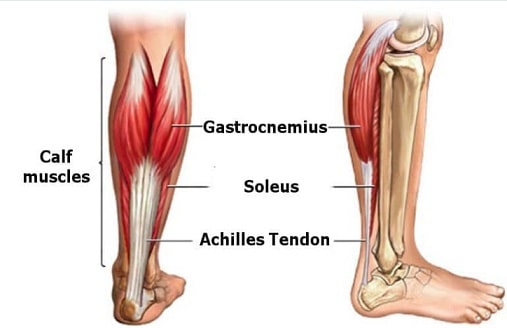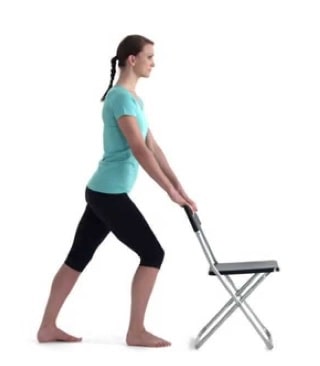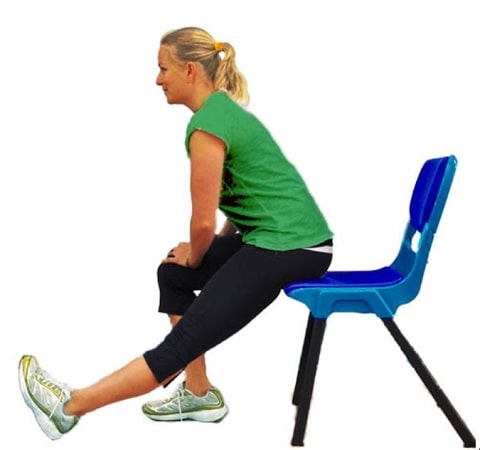It is essential that you understand and learn calf pain relief exercises that will help you reduce and protect your leg muscles from any potential pain.
Why it’s important!
Because the calf muscle is an essential part of the lower leg, which consists of two main muscles gastrocnemius “the upper part of the calf” and the soleus “the lower part of the calf” that connects with the Achilles tendon and attaches with the heel bone.
Which in the end is responsible for balancing the body during movement, in addition, there are many reasons why calves get injured and hinder their functions.

Based on this, before we begin to perform relief exercises, it is important to identify the problems that result from calf muscle pain, what are the symptoms and causes?
What are the reasons that lead to tight calves, and stretches that solve the problem! How to prevent future exposure to pain.
Let’s dive into the article and find out how to treat calves pain, by first knowing its symptoms and causes:
Calf Pain Symptoms
Why is it important to understand the symptoms of calves pain? The reason is that our bodies can experience different types of pain in many parts.
But we need to determine if the condition you’re currently experiencing is caused by a calves injury, or a different other muscle part being injured and causing our calf pain in this manner, since each muscle has a different way of dealing with it.
Symptoms vary depending on the main root cause. Here are the common symptoms:
- Tingling sensation, feel uncomfortable or difficulty touching the skin of the lower leg or behind the knee. Cramps that may last from a few seconds to 10 minutes.
- Unexpected pain in the lower leg.
- Difficulty in standing or moving.
- Skin discoloration behind the knee.
- Pain, especially when pressing on the back of the leg, distention or trauma.
Causes of Calf Muscle Pain
Calf pain can result based on a number of causes, which vary with the types of injury in some activities that will focus more on the article, or as a result of a potential illness.
- Calf Strain: This is one of the common causes of pain in calves, as a consequence of overuse, excessive lifting of heavy weights, incorrect movement steps of the exercise or high stress of the muscles. Similar exercises such as lifting, sprinting or swimming.
- Calf Cramp: It is an unexpected muscle tension that lasts for some time, either a few seconds or minutes, and the reason for starting a new workout, or exercising continuously without rest.
- Achilles Tendon Inflammation: Straining the calves tendon can lead to reduce leg range of motion and pain in the back leg.
- Sciatica: If a hip nerve injury occurs, this can lead to severe leg pain for some cases, that required to get a medical attention.
- Bruise: A sudden injury either a fall or hit, can result damage the blood vessels in that area, resulting in contrast skin color.
Calf Pain Relief Exercises
Regularly using stretching exercises such as walking or running, before you start doing intense muscle exercises, can help you avoid muscle pain or injury.
You need to participate daily in these exercises in order to improve flexibility and range of motion and set up a mindset for the muscles to be ready before startup any workout.
1. Calf Chair Stretch Forward

-
- Stand in front of a chair, and grab the upper back of the chair from the back with both hands.
- Put your right leg forward and send your left leg back.
- Bend the right knee leg at 140 degrees, keeping the left leg always straight.
- While both of your feet are flat on the floor, now slowly bend forward toward the chair, by bending the right knee leg up to 90 degrees as far as possible. Pause in this position for half a minute, and feel the calf stretch into the back leg.
- Return the right leg back to 140 degrees.
- Switch legs and repeat 4 times.
2. Calf Chair Stretch Backward
This exercise is similar to the first stretch, with a slight change by bending the back leg.
-
- While standing in front of the back chair, grip the chair with both hands.
- Put your right leg forward with a slight bend, while set the left leg backward to be straight (keep one foot distance between two feet).
- Then bend your left knee forward to 90 degrees, securing both feet flat on the floor.
- Freeze this position for 1/2 minute.
- Then switch and change to other leg, and repeat 3 times.
3. Calf Raise
-
- Stand on a wooden stool or a low height step, with your toes and the ball of your foot on the step, while bringing your heels off the step.
- Place your hand either on your hips or grab something for body balance.
- Gradually start dropping the heel, but do not touch the floor, freeze in this position.
- Then raise the heels above the height of the step level.
- Repeat 3-4 times.
4. Calf Stretch While Seated

In the event that you are unable to stand up well, this exercise will allow you to fully extend your calves and back leg while seated.
-
- Grab a chair or bench and sit on the edge of the end, while your head and back are aligned straight during the entire exercise.
- Put one leg straight by balancing only on your heels, bend the other leg knee 90 degrees as normally and keeping the feet flat on the floor, place both hands on top of the thigh of this bent leg. This is your starting position.
- Inhale, then slowly bend your chest forward as far as possible, so your torso and extended leg are shaped about 90 degrees. Hold this position for half a minute.
- Exhale, then reverse your back to the starting position, then repeat 4 times.
- Switch legs and repeat the same steps.
Calves Pain After Workout
If you experience calf pain or stiffness a few hours after your workout finish or the next day, this is usually a normal muscle response after a busy workout day, and will likely go away after a few days.
In the meantime, you can still reduce the effect of pain or muscle tightness by following these steps:
- Massage: Gently rub the affected area, either with your hands in small circles or with a foam roller to release calf muscle strain of calves and stretch the muscles.
- Apply Comfort Balms: Use either a muscle cream for quick relief from aches and joints or menthol oil, both of which provide a warming sensation and disconnect the pain in a short time.
- Use Warm Water: Muscle heating helps relieve pain with warm feelings, use hot water in the bath and focus water on the pain area for a while, this will gradually reduce the tension on the muscles.
- Perform Light Exercise: Engaging yourself in cardio activities will reduce pain or tight calves muscles.
How to Stop Calf Pain?
It is best to take more precautionary steps that will prevent you from feeling calves pain causes as much as possible.
- Keep Your Body Hydrated: Drink sufficient water while exercising or during any strenuous activity, while avoiding cramps in your calves, as more studies focus on this method, you can use hydrocell water bottle to drink 24 hours cold water.
- Stay Stretching: This is an essential part, in case you want to protect not only your calves but also the whole body, warm up before and after your workout to prepare your muscles for the strength routine. This will reduce the chances of muscle pain and serious injuries.
- Progressive Intense Routine: Gradually using weights and intensity in your workouts, will prevent you from suffering potential pain, especially if you start a completely new to working out, you need to be aware by performing the correct exercise steps and not start too heavy.
Treatment Calve Pain at Home
The rehabilitation of the calves muscles can be varied, and it depends on the cases of injuries, whether mild to moderate level.
- ICE: Applying ice to an injured calf will reduce pain and absorb the area of tension or swelling.
- Elevating: It is wise to raise the calves above the level of the heart, this will reduce the blood pressure in this area.
- Compress: Add extra pressure to the affected area to reduce any bruising or swelling if exists.
- Resting: Its important role for any stressed muscle that some people can neglect, is to restore muscle and tissue recovery and rebuilding process by just resting.
- Stretching: As mentioned earlier, these exercises stimulate the muscles to receive the exercise or routine stress correctly, and it is also important after completing the exercise to continue to stretch, to cool the muscles and return to their normal position.
Conclusion
Be aware of the pain of the calves when raised, and try to identify the exact problem, as it may be mild to the level of severe injury, in addition, some of these conditions can usually be treated at home with the proposed solutions suggested above, and there are other serious cases that require medical attention.
For most common cases, calf pain relief exercises can be applied and treated at home, but you need to proactively prevent future cases so you don’t suffer again.
Additional exciting exercises can be performed using light banded squats that will make a big difference in stretching your muscles anytime you want and providing the flexibility you need.
If you have any question or inquiry, please add your comment below, I will be happy to help you.
